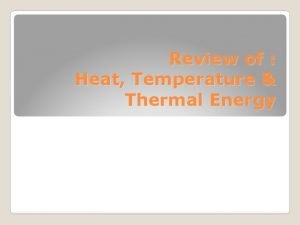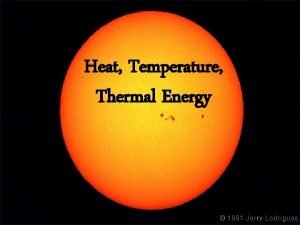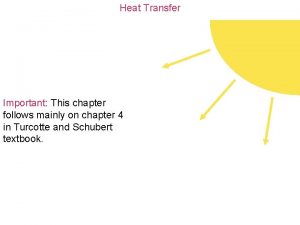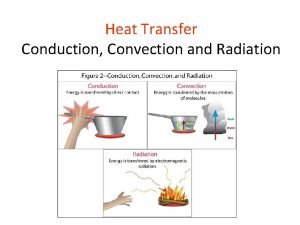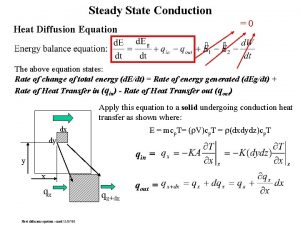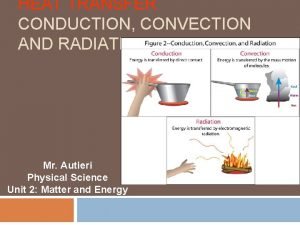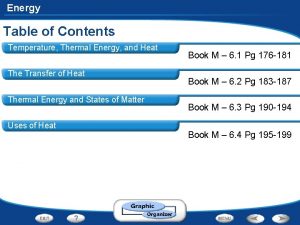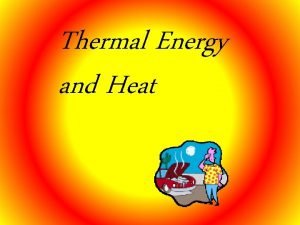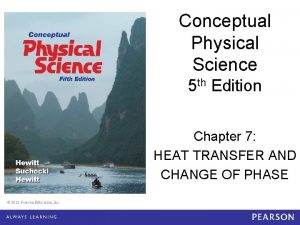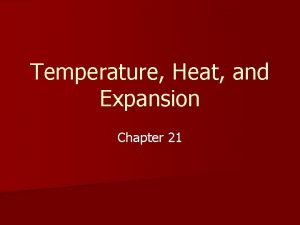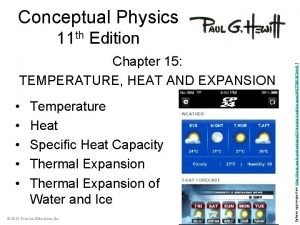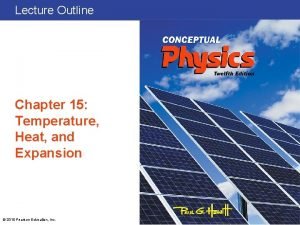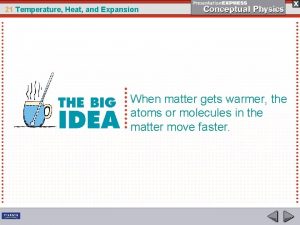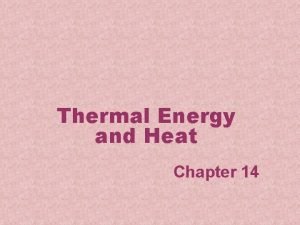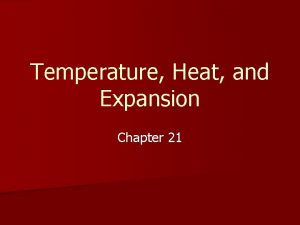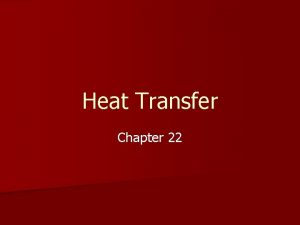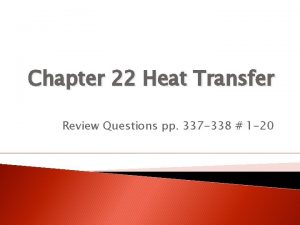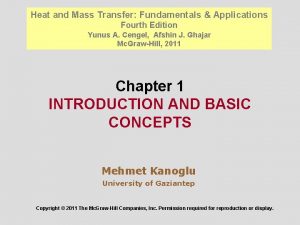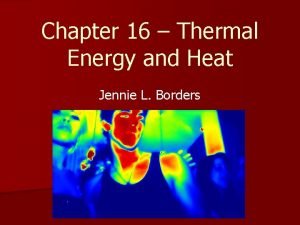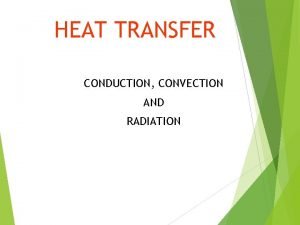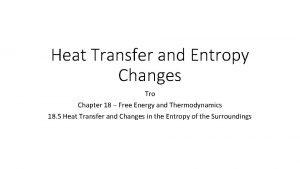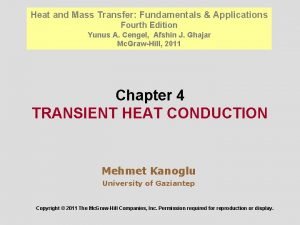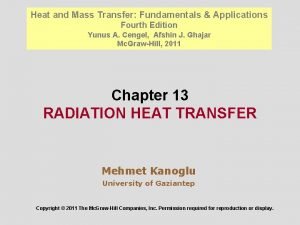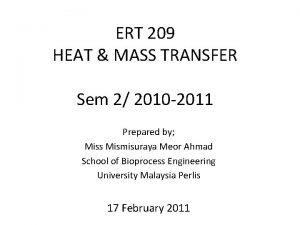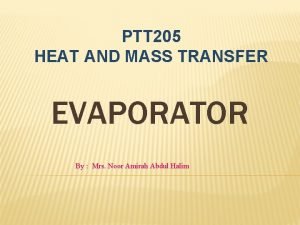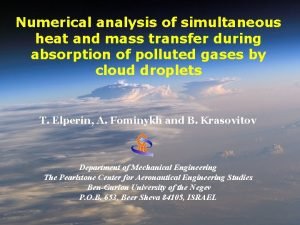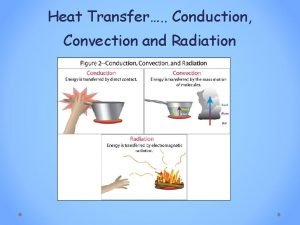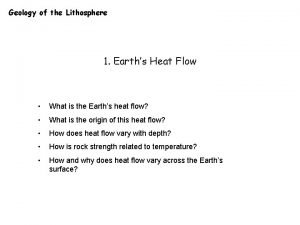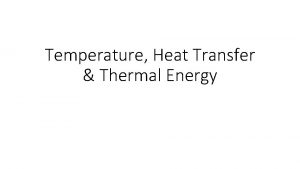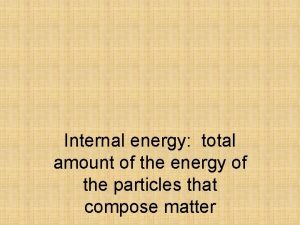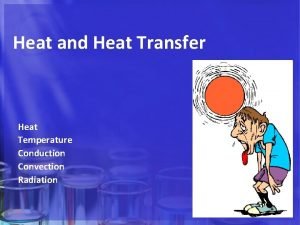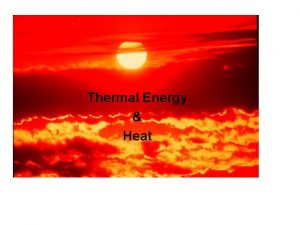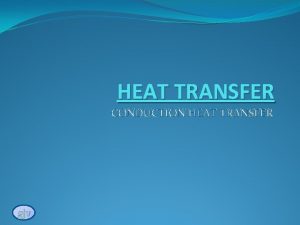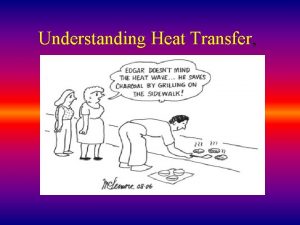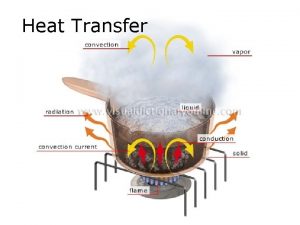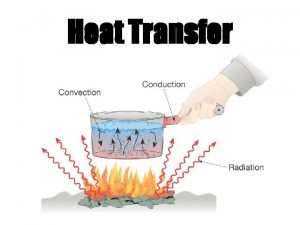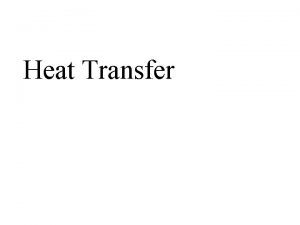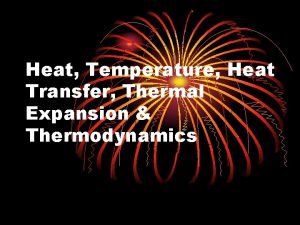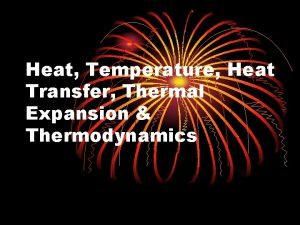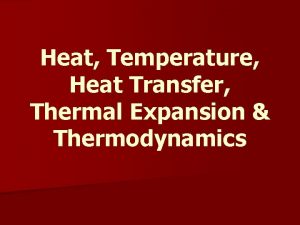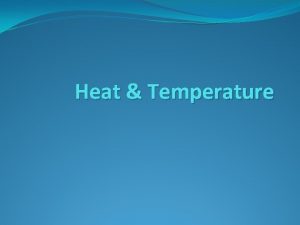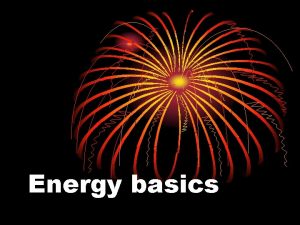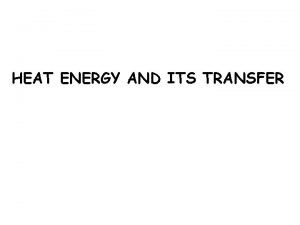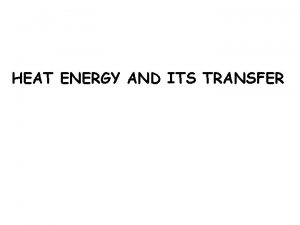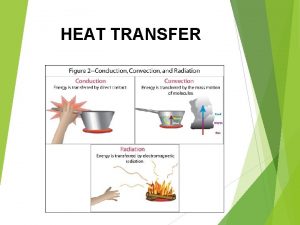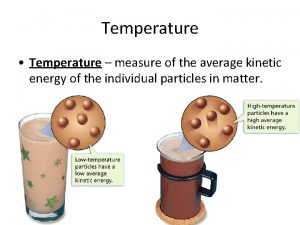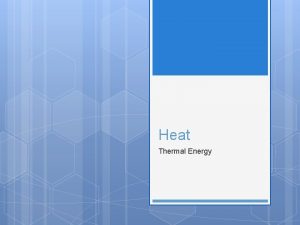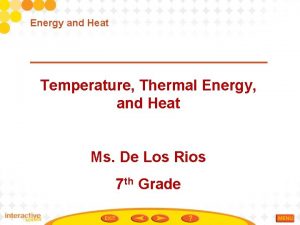Chapter 14 Heat and Temperature Temperature Energy Transfer




![Section 1 - Temperature • Key Questions: • 1] What does temperature have to Section 1 - Temperature • Key Questions: • 1] What does temperature have to](https://slidetodoc.com/presentation_image_h2/cd68af5d7dfb874bd2b8bf88a1da81e5/image-5.jpg)






![Section 2 – Heat Transfer • Key Questions: • 1] How does energy transfer Section 2 – Heat Transfer • Key Questions: • 1] How does energy transfer](https://slidetodoc.com/presentation_image_h2/cd68af5d7dfb874bd2b8bf88a1da81e5/image-12.jpg)











![Heat Flow Conceptual Practice • Scenarios – Explain what is happening: • 1] You Heat Flow Conceptual Practice • Scenarios – Explain what is happening: • 1] You](https://slidetodoc.com/presentation_image_h2/cd68af5d7dfb874bd2b8bf88a1da81e5/image-24.jpg)






![Section 3 – Using Heat • Key Questions: • 1] What happens to heat Section 3 – Using Heat • Key Questions: • 1] What happens to heat](https://slidetodoc.com/presentation_image_h2/cd68af5d7dfb874bd2b8bf88a1da81e5/image-31.jpg)









- Slides: 40

Chapter 14 Heat and Temperature: Temperature Energy Transfer Using Heat

TN Standards • CLE 3202. 2. 3 – Examine the applications and effects of heat energy • CLE. 3202. 2. 6 – Investigate the Law of Conservation of Energy • CLE. 3202. TE. 3 – Explain the relationship between the properties of a material and the use of the material in the application of a technology

TN Standards • SPI. 3231. 2. 1 – Relate temperature changes with the changes of kinetic energy and the flow of heat energy

Bellwork • What is temperature? • Average kinetic energy of particles in a material
![Section 1 Temperature Key Questions 1 What does temperature have to Section 1 - Temperature • Key Questions: • 1] What does temperature have to](https://slidetodoc.com/presentation_image_h2/cd68af5d7dfb874bd2b8bf88a1da81e5/image-5.jpg)
Section 1 - Temperature • Key Questions: • 1] What does temperature have to do with energy? • 2] What three temperature scales are commonly used? • 3] What makes things feel hot or cold?

Temperature and Energy • Kinetic theory of matter – Matter is made of small particles always moving – Higher temperature, more motion – Large particles move slower • The temperature of a substance is proportional to the average kinetic energy of the substance’s particles • All particles have kinetic energy ( atomic )

Measuring Temperature • As materials are heated, they expand • Thermometers rely on expansion of liquids – Mercury or Alcohol • Thermostats rely on expansion of metals

Temperature Scales • Units: Fahrenheit ( English ) and Celsius ( metric ) • Fahrenheit is English • Celsius/Kelvin is metric • Kelvin is an absolute scale – Absolute zero at -273. 15 o. C

Temperature Scales - Converting • Celsius Fahrenheit: TF = 1. 8*TC + 32. 0 • Fahrenheit Celsius: TC = ( TF – 32. 0 ) / 1. 8

Temperature Scales - Converting • Celsius Kelvin: TK = TC + 273. 15 • Kelvin Celsius: TC = TK - 273. 15

Temperature & Energy Transfer • When you feel “hot” or “cold” you are detecting a temperature difference • You are also feeling the affects of energy transfer • Temperature changes indicate an energy transfer – temperature difference between two objects is felt as heat • Heat is the energy transferred between objects of different temperature
![Section 2 Heat Transfer Key Questions 1 How does energy transfer Section 2 – Heat Transfer • Key Questions: • 1] How does energy transfer](https://slidetodoc.com/presentation_image_h2/cd68af5d7dfb874bd2b8bf88a1da81e5/image-12.jpg)
Section 2 – Heat Transfer • Key Questions: • 1] How does energy transfer happen? • 2] What do conductors and insulators do? • 3] What makes something a good conductor of heat?

Energy Transfer ( Heat Flow ) • What is happening in each picture • Explain how heat is flowing ( ID how heat goes from one object to another ) • What might be happening on the atomic level?

Different Methods of Transfer

Different Methods of Transfer • Conduction occurs between objects in direct contact • Thermal Conduction–heat source is one object

Different Methods of Transfer • Convection results from the movement of warm fluids ( in contact with heat source ) • Warm fluids rise – Cool when away from heat • Cool fluids fall • Convection current – Path of warm/cool fluids

Different Methods of Transfer • Radiation does not require physical contact between objects • Energy transferred as electromagnetic waves

Conductors & Insulators • A conductor is a material through which energy can be easily transferred as heat • An insulator is a material that transfers energy poorly • Heat energy is transferred through particle collisions

Conductors & Insulators • Heat energy is transferred through particle collisions • Gases – poor conductors – Why? • Denser materials usually are better conductors than less dense • Metals – very good conductors • Plastics – poor conductors

Bellwork – 11/21/14 • When you melt ice, is heat going to be added to the water, or removed from it? • Add heat

Specific Heat • Determines how easily energy can be transferred as heat • How much energy is needed to change the temperature of a substance by a certain amount

Specific Heat • Amount of energy needed to raise the temperature of 1 kg of substance by 1 K • 1 degree change in C = 1 degree change K • Energy = specific heat x mass x temp change • Energy = cmΔT • c = energy /(mΔT)

Specific Heat • Temperature does not change when phases do; energy goes into phase change - not temperature adjustment • Latent heat ( melting ) & Heat of Fusion ( evap ) – Gives amount of energy needed for phase change
![Heat Flow Conceptual Practice Scenarios Explain what is happening 1 You Heat Flow Conceptual Practice • Scenarios – Explain what is happening: • 1] You](https://slidetodoc.com/presentation_image_h2/cd68af5d7dfb874bd2b8bf88a1da81e5/image-24.jpg)
Heat Flow Conceptual Practice • Scenarios – Explain what is happening: • 1] You pick up a coffee cup and it is hot • 2] You touch a glass of cold SCHAWEET tea • 3] A breeze makes you shiver

Heat Flow Conceptual Practice • Which substance can you heat the quickest? • One with a large or small heat capacity?

Heat Flow Math Practice • How much energy must be transferred as heat to 200 kg of water ( c = 4, 186 J/kg/K ) in a bathtub to raise its temperature from 25 o. C to 37 o. C? :

Specific Heat Example • The temperature of a substance increases by 7 K when 1850 J is added to a 5 kg quantity of the substance. What is the specific heat ( c )?

Specific Heat Example • The temperature of a substance increases by 7 K when 1850 J is added to a 5 kg quantity of the substance. What is the specific heat ( c )? • 1850 / (5 * 7 ) = 52. 9 J/(kg*K)

Specific Heat Example • Temperature of 2. 5 kg ethanol is 47 o. C. What will the final temp be if 90, 000 J of heat energy [ c = 2440 J/(kg*K) ].

Specific Heat Example • Temperature of 2. 5 kg ethanol is 47 o. C. What will the final temp be if 90, 000 J of heat energy [ c = 2440 J/(kg*K) ]. • ∆T = 90000/(2. 5 * 2440) = 14. 75 degrees C or K • Final Temp = 14. 75 + 47 = 61. 8 o. C
![Section 3 Using Heat Key Questions 1 What happens to heat Section 3 – Using Heat • Key Questions: • 1] What happens to heat](https://slidetodoc.com/presentation_image_h2/cd68af5d7dfb874bd2b8bf88a1da81e5/image-31.jpg)
Section 3 – Using Heat • Key Questions: • 1] What happens to heat energy when it is transferred? • 2] What do heat engines do?

Thermodynamics • 1 st Law – total energy used in any process is conserved, whether that energy is transferred as work, heat, or both.

Thermodynamics • 2 nd Law – energy transferred as heat ALWAYS moves from higher to lower temperature. Another way of saying “Energy is always conserved. ”

Thermodynamics • Entropy – randomness or disorder of a system • Thermo [3 rd Law] tells us that total entropy of the universe is ALWAYS increasing ( natural tendency )

What is a System? • A “system” is defined as the area, volume and/or group of objects being analyzed • Systems can be open or closed • Closed system – like a can of coke or soup that has not been opened • Open system – once you open that can of coke or soup

Heat Engines • Heat Engines – chemical energy is converted into mechanical energy by combustion

Heat Engines

Using Heat • Rubbing alcohol applied to the skin – what happens/what do you observe? • Why?

Using Heat • Rubbing alcohol applied to the skin – what happens/what do you observe? • Why?

Using Heat • cooling/heating processes utilize this • SWEATING! • Fluids—liquids & gases—are chosen that easily evaporate and condense • Evaporation – energy is absorbed by the fluid/sweat ( from surrounding air ) • Condensation – energy is released by the fluid/moisture ( absorbed by air )
 Energy energy transfer and general energy analysis
Energy energy transfer and general energy analysis Energy energy transfer and general energy analysis
Energy energy transfer and general energy analysis What is heat energy?
What is heat energy? Heat thermal energy and temperature
Heat thermal energy and temperature Thermal energy vs heat
Thermal energy vs heat How does conduction transfer heat
How does conduction transfer heat Conservation of energy heat transfer
Conservation of energy heat transfer Example of convection heat transfer
Example of convection heat transfer Diffusion equation
Diffusion equation Identify heat transfer shown in each picture
Identify heat transfer shown in each picture Heat vs thermal energy vs temperature
Heat vs thermal energy vs temperature Is temperature a measure of thermal energy
Is temperature a measure of thermal energy Chapter 7 heat transfer and change of phase
Chapter 7 heat transfer and change of phase Specific heat of platinum
Specific heat of platinum Chapter 15 temperature heat and expansion
Chapter 15 temperature heat and expansion Chapter 21 temperature, heat and expansion answer key
Chapter 21 temperature, heat and expansion answer key Chapter 21 temperature, heat and expansion answer key
Chapter 21 temperature, heat and expansion answer key Chapter 14 section 1 heat and temperature answers
Chapter 14 section 1 heat and temperature answers Chapter 21 temperature heat and expansion
Chapter 21 temperature heat and expansion Chapter 21 temperature heat and expansion
Chapter 21 temperature heat and expansion Chapter 22 heat transfer
Chapter 22 heat transfer Chapter 22 heat transfer
Chapter 22 heat transfer Heat and mass transfer fundamentals and applications
Heat and mass transfer fundamentals and applications Thermal energy vs heat energy
Thermal energy vs heat energy Chapter 16 thermal energy and heat
Chapter 16 thermal energy and heat What is heat transfer conduction convection and radiation
What is heat transfer conduction convection and radiation Conduction convection radiation examples
Conduction convection radiation examples Entropy and heat transfer
Entropy and heat transfer Heat and mass transfer cengel 4th edition pdf
Heat and mass transfer cengel 4th edition pdf Fundamental of heat and mass transfer
Fundamental of heat and mass transfer Bulk temperature formula
Bulk temperature formula Heat and mass transfer
Heat and mass transfer Simultaneous heat and mass transfer
Simultaneous heat and mass transfer Radiation travels in straight lines
Radiation travels in straight lines Heat-mass transfer and geodynamics of the lithosphere:
Heat-mass transfer and geodynamics of the lithosphere: Thermal resistance formula
Thermal resistance formula Difference between curie temperature and neel temperature
Difference between curie temperature and neel temperature Difference between curie temperature and neel temperature
Difference between curie temperature and neel temperature Ferrimagnetism
Ferrimagnetism Thermal vs heat energy
Thermal vs heat energy What is the difference in heat and temperature
What is the difference in heat and temperature



